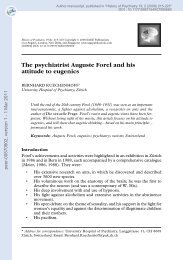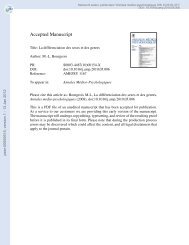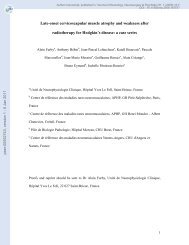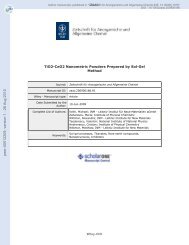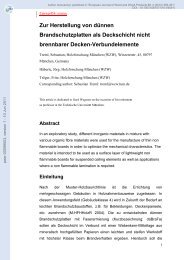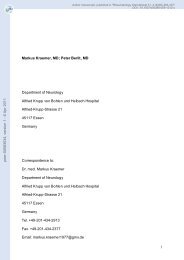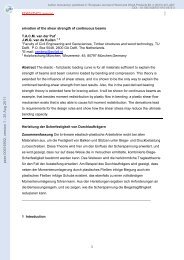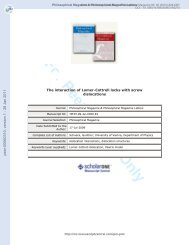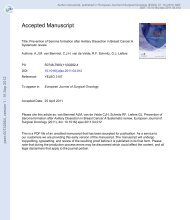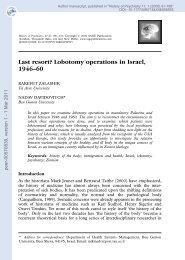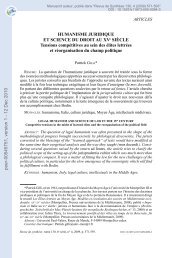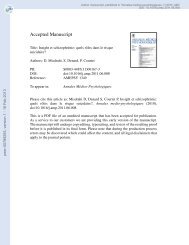Monitoring of Polycyclic Aromatic Hydrocarbons (PAH) in food ...
Monitoring of Polycyclic Aromatic Hydrocarbons (PAH) in food ...
Monitoring of Polycyclic Aromatic Hydrocarbons (PAH) in food ...
You also want an ePaper? Increase the reach of your titles
YUMPU automatically turns print PDFs into web optimized ePapers that Google loves.
1<br />
2<br />
3<br />
4<br />
5<br />
6<br />
7<br />
8<br />
9<br />
10<br />
11<br />
12<br />
13<br />
14<br />
15<br />
16<br />
17<br />
18<br />
19<br />
20<br />
21<br />
22<br />
23<br />
24<br />
25<br />
26<br />
27<br />
28<br />
29<br />
30<br />
31<br />
32<br />
33<br />
34<br />
35<br />
36<br />
37<br />
38<br />
39<br />
40<br />
peer-00704676, version 1 - 6 Jun 2012<br />
41<br />
42<br />
43<br />
44<br />
45<br />
46<br />
47<br />
48<br />
49<br />
50<br />
51<br />
52<br />
53<br />
54<br />
55<br />
56<br />
57<br />
58<br />
59<br />
60<br />
steps that also concentrate <strong>PAH</strong>, as was suggested to occur <strong>in</strong> the production process <strong>of</strong> natural vitam<strong>in</strong> E by<br />
Horrob<strong>in</strong> and Manku (1997).<br />
Marg<strong>in</strong>s <strong>of</strong> exposure for dietary <strong>PAH</strong> <strong>in</strong> the EU<br />
Food Additives and Contam<strong>in</strong>ants<br />
EFSA calculated <strong>in</strong> their Op<strong>in</strong>ion on <strong>PAH</strong> <strong>in</strong> <strong>food</strong> marg<strong>in</strong>s <strong>of</strong> exposure (MOEs) for benzo[a]pyrene, <strong>PAH</strong>2, <strong>PAH</strong>4,<br />
and <strong>PAH</strong>8 by divid<strong>in</strong>g the lowest Benchmark Dose Lower Confidence Limit associated with an extra 10% cancer<br />
For Peer Review Only<br />
risk relative to background <strong>in</strong>cidence (BMDL10) by the estimated mean exposure to these <strong>PAH</strong> <strong>in</strong> the EU (EFSA<br />
2008b). From the estimated mean dietary exposure to <strong>PAH</strong>4 <strong>in</strong> the EU <strong>of</strong> 19.5 ng per kg body weight per day (ng<br />
kg bw -1 day -1 ) and the lowest BMDL10 for <strong>PAH</strong>4 identified by EFSA <strong>of</strong> 0.34 mg kg bw -1 day -1 , an MOE <strong>of</strong> 17,500<br />
applicable to consumers at average exposure levels was calculated (EFSA 2008b). Similarly, for the 97.5 th<br />
percentile <strong>of</strong> the estimated dietary exposure to <strong>PAH</strong>4 <strong>in</strong> the EU <strong>of</strong> 34.5 ng kg bw -1 day -1 , an MOE <strong>of</strong> 9900<br />
applicable to these high-level consumers was derived. Furthermore, MOEs were calculated us<strong>in</strong>g <strong>PAH</strong>8 as<br />
marker for carc<strong>in</strong>ogenic <strong>PAH</strong> <strong>in</strong> <strong>food</strong>, which amounted to an MOE <strong>of</strong> 17,000 for consumers at average exposure<br />
levels and an MOE <strong>of</strong> 9600 for consumers at high exposure levels (EFSA 2008b). EFSA concluded that the<br />
MOEs calculated for average consumers <strong>in</strong>dicated a low concern for consumer health, but that the MOEs for high<br />
level consumers are close to or less than 10,000, which <strong>in</strong>dicates a potential concern for consumer health and a<br />
possible need for risk management action (EFSA 2005; EFSA 2008b).<br />
Marg<strong>in</strong>s <strong>of</strong> exposure for <strong>PAH</strong> <strong>in</strong> <strong>food</strong> supplements with high <strong>PAH</strong> levels<br />
In the current study, the highest estimated daily exposure to <strong>PAH</strong>4 <strong>of</strong> 705 ng was calculated for a multi-<strong>in</strong>gredient<br />
botanical <strong>food</strong> supplement with resveratrol (No. 13 from Table 9). Assum<strong>in</strong>g a body weight <strong>of</strong> 60 kg, the exposure<br />
to <strong>PAH</strong>4 with this supplement used at the maximum recommended dose level would amount to 11.7 ng kg bw -1<br />
day -1 . From this value and the lowest BMDL10 value for <strong>PAH</strong>4 identified as acceptable by EFSA <strong>of</strong> 0.34 mg kg<br />
bw -1 day -1 (EFSA 2008b), an MOE <strong>of</strong> 28,900 (rounded <strong>of</strong>f to the nearest 100) was calculated. Similarly, MOEs<br />
calculated for the daily exposure to benzo[a]pyrene, <strong>PAH</strong>2, and <strong>PAH</strong>8(-IcP) from this supplement at the<br />
recommended dose level by us<strong>in</strong>g BMDL10 values <strong>of</strong> respectively 0.07, 0.17, and 0.49 mg kg bw -1 day -1 (EFSA<br />
2008b), were 24,600 for benzo[a]pyrene, 25,500 for <strong>PAH</strong>2, and 31,500 for <strong>PAH</strong>8(-IcP). Although these MOEs<br />
were higher than 10,000, the estimated daily benzo[a]pyrene <strong>in</strong>take <strong>of</strong> 2.85 ng kg bw -1 day -1 with this supplement<br />
http://mc.manuscriptcentral.com/tfac Email: fac@tandf.co.uk<br />
18<br />
Page 18 <strong>of</strong> 40




